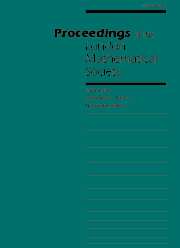On Algorithmic Equi-Resolution and Stratification of Hilbert Schemes
Published online by Cambridge University Press: 09 June 2003
Abstract
Given an algorithm for resolution of singularities that satisfies certain conditions (‘a good algorithm’), natural notions of simultaneous algorithmic resolution, and of equi-resolution, for families of embedded schemes (parametrized by a reduced scheme $T$) are defined. It is proved that these notions are equivalent. Something similar is done for families of sheaves of ideals, where the goal is algorithmic simultaneous principalization. A consequence is that given a family of embedded schemes over a reduced $T$, this parameter scheme can be naturally expressed as a disjoint union of locally closed sets $T_j$, such that the induced family on each part $T_j$ is equi-resolvable. In particular, this can be applied to the Hilbert scheme of a smooth projective variety; in fact, our result shows that, in characteristic zero, the underlying topological space of any Hilbert scheme parametrizing embedded schemes can be naturally stratified in equi-resolvable families.
Keywords
- Type
- Research Article
- Information
- Copyright
- 2003 London Mathematical Society
Footnotes
- 9
- Cited by


